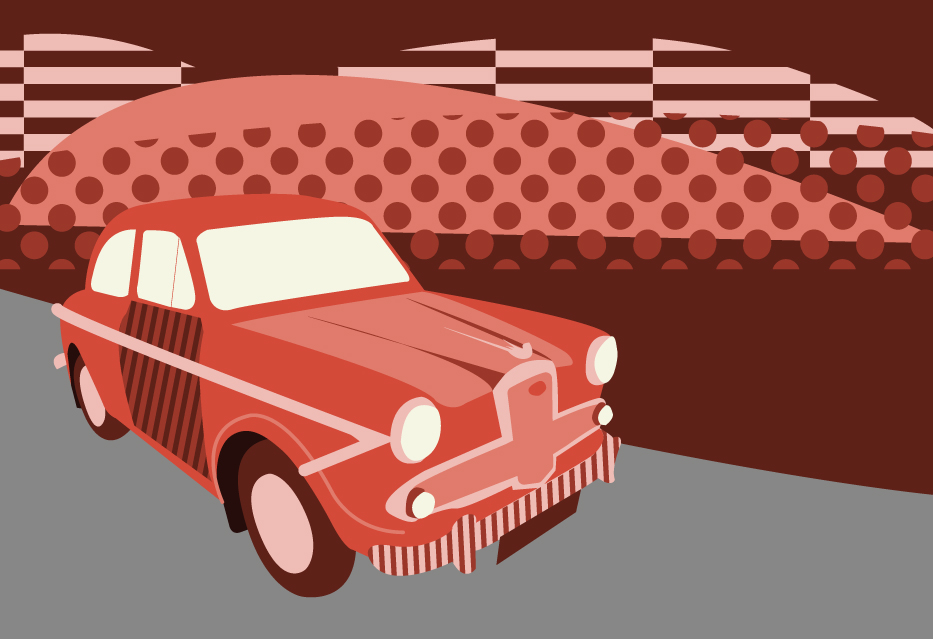Citroën already had a reputation for building extraordinary cars long before the extravagant, Maserati-powered SM stunned the motoring world in 1970.
The 2CV had provided affordable motoring for the masses, while the technologically advanced and boldly-styled DS drew gasps on its launch in 1955.
The space-age SM was even more audacious, marrying sports car performance from Italy with Citroën’s legendary technical innovations.
So how, and why, did this sumptuous French flagship come to market?
How do you take something so good, so iconic and so popular as the Citroën DS and move it to the next level?
The French company had long wanted to create a new flagship model for the nation, something to fill the void left by the demise of Facel Vega – but they lacked a suitable engine to really make any development of the DS fly.
Although early prototypes, using a shortened version of the DS, proved successful in motorsport, an upgrade on the donor car’s engine – which had its roots in the pre-war unit of the Traction Avant – was clearly needed if Citroën was to realise its mission of creating a class-leading grand tourer.
Plans were drawn up to create a new six-cylinder unit produced in-house, but what happened in January 1968 was to prove a game-changer in the development of Project S – the SM’s codename.
Unlikely marriage with Maserati
At the time, mergers and acquisitions were all the rage across Europe, but Citroën’s purchase of a controlling interest in Maserati raised more than a few eyebrows.
To Citroën boss Pierre Bercot, though, it made perfect sense for the development of Project S.
Work on Citroën’s own six-cylinder powerplant was shelved, and Maserati’s chief engineer Giulio Alfieri was tasked with designing a new V6 for the SM.
Two cylinders were lopped off the Maserati Indy’s 4136cc V8, along with other changes to bore and stroke, to create a tax-friendly 2670cc V6.
The all-aluminium new unit weighed in at only 140kg dry, was developed from scratch in just three weeks and produced 170bhp when married to three Weber 42DCNF2 carburettors.
Technical innovations
Under the skin, the SM carried over some of the innovations that made the DS decades ahead of its time, including a refined version of the earlier car’s hydropneumatic suspension, while discs all round replaced the DS’s disc and drum combination.
The biggest step forward was in the steering, with the SM’s speed-sensitive system known as DIrection à RAppel asserVI (DIRAVI), characterised by its incredibly high gearing – just two turns from lock to lock – and its hydraulically-assisted self-centring.
The faster you went, the heavier the steering became, providing a greater feel than systems which remained light at any speed.
The high-gearing and speed-sensitive system was controversial to start with, and many road testers thought it would take drivers some time to get used to it.
But once they had, it proved popular, and it would go on to be used in the Citroën CX.
The windscreen wiper system featured an early form of rain sensitivity when on the low speed setting, while the steering column had height and reach adjustment.
Breathtaking styling
Designed by Citroën’s chief designer Robert Opron, if the intention was to create the same sort of sensation as the DS had 15 years earlier, it surely succeeded.
Both inside and out, the car was a modernist’s delight, with a long bonnet, curved rear window and drooping tapered flanks winning plenty of admirers, as well as a few detractors.
CAR magazine described the SM’s fascia as though it was “designed for something being fired out of Cape Kennedy rather than merely as a car instrument panel”.
The car’s drag coefficient of 0.26 was streets ahead of any other saloon, with its glazed-in headlamps (six of them) also causing a stir – the inner two lights swivelled with the steering, allowing drivers to see round corners.
Everything about the car had a premium feel, from the high quality interior to the aircraft-grade aluminium used for the bonnet and stainless steel for the brightwork.
At the time of its launch at the Geneva Auto Salon in 1970, alongside the GS, it was the world’s fastest front wheel drive car, with a top speed of 137mph, though independent tests achieved higher.
This was French cool in motoring form – different, outrageous and technologically years ahead of its time.
Adrian Flux Classic Car Insurance
On the road
Sold in France from 1970, the UK had to wait until the following year and, even then, the cars were only available in left hand drive – although a tiny number of right hand drive conversions were undertaken.
Its competition included the likes of the home-grown Jensen Interceptor, and Germany’s BMW 3.0CS and Mercedes 450 SLC.
CAR magazine chose the BMW as its chief rival when they got their hands on a Citroën in December 1971, and were blown away by the car’s technological brilliance, and its overall aura.
“Just as a Festival Hall audience knows when it is hearing a master at work, just as the crowd at Old Trafford roars when George Best sidesteps three defenders and scores the winning goal, so were we aware that we were in the presence of greatness,” the magazine gushed.
“We were all too conscious that we were handling something out of the ordinary. The speedometer needle was flickering around at highly illegal speeds yet the car seemed to be wafting along at 50mph, the suspension literally soaking up the undulating road surface and ignoring potholes and manhole covers as if they did not exist.”
Before testing the SM, they were equally convinced they were driving a very fine car in the BMW, but the “mechanical sophistication of the Citroën” put it in a different league.
“The Citroën bristles with innovation from front to rear, and just to open its bonnet has got to be the biggest bit of one-upmanship ever,” it said.
The SM was hardly cheap, coming in at around the same price as a Ferrari Dino 246 and a Porsche 911, at £5,200 including extras like leather and air conditioning.
Although slower to 60mph than those cars by at least a second, the SM could achieve similar top speeds, and in the sort of comfort those out and out sports cars could never achieve – nor were they designed to.
The self-levelling suspension carried over from the DS saw the car waft along with hitherto unheard of grace.
“The SM probably has the most outstanding ride of any car in the world today,” said the magazine.
“On some of the few remaining stretches of cobbled road in London it totally ignored the surface, only road rumble through the chassis indicating that the surface was anything out of the ordinary, while traversing a normally bumpy level crossing made us wonder if the rails had been removed. They hadn’t.”
CAR tested the SM again in 1974, pitting it against a Lotus Elite and Porsche 911 – not really its intended competition, but never mind.
Needless to say, it was slower off the mark than those sportsters, yet by the 50mph mark it had comfortably over-hauled the Lotus, if not the Porsche.
Again, the test highlighted the need to get to know the SM’s innovative steering before it could be driven with confidence.
“It takes longer to get to know the Citroën SM than just about any other car,” it wrote. “It all centres around the incredibly quick steering – power assisted and just two turns lock-to-lock. “Turn the wheel too sharply and you’ll cross the road and disappear off the other side. Smoothness and minute guiding movements are the answer. Then you begin to love the SM.”
It’s a car to “put away really long distances at a sustained and very rapid rate”, a “very safe, refined, four-seater GT” with a “magic carpet” ride.
After a 10,000-mile test, Autocar editor Ray Hutton wrote: “The Maserati V6 engine emits a splendid racing growl under hard acceleration and has quite a harsh feel to it when working hard.
“Similarly, the manual five-speed gearbox has a precise ‘gated’ change that would not be out of place in an Italian sports car.”
And while most contemporary road tests marvelled at the car’s technical excellence, it was also a supreme attention grabber.
“Even in France it turns heads and, in the little villages of La Mancha in Central Spain, the inhabitants treated it with the suspicion and wonder of something from Outer Space,” wrote Hutton.
“It is a strange mixture, the SM. Mechanically ornate; simple in line; beautiful yet functional. A girl friend of mine described it as ‘the sexiest car in the world’. I know what she means.”
The SM placed third behind its little sister, the GS, in the 1971 European Car of the Year, before winning the following year’s Motor Trend car of the year award in the US, their first foreign winner.
Reliability issues and development
Unfortunately, this incredibly complex car suffered teething problems and soon gained a reputation for fragility.
Not because of the tried-and-tested suspension system, fiendishly complicated though it was, but because of the Maserati engine.
There were issues with the rear timing chains that drove the V6’s overhead camshafts, while the oil pump and ignition system were also failure-prone, as was the air-conditioning.
Citroën did little to mitigate these known problems, and development of the car was also limited during its five-year lifespan.
Electronic fuel injection was added in 1972, and a 3.0-litre automatic was introduced the following year.
But the SM’s honeymoon period was brief. After 4,988 had rolled off the production lines in its first full year of production, 1971, just 2,619 were made two years later.
Several factors played a part in its downfall – the oil crisis of the early 1970s severely affected sales of all large cars, while in the US, Citroën failed to get the exemption it expected from 5mph bumper regulations in 1974. It effectively pulled out of the US market.
That, and the need for separate Citroën and Maserati specialists to service the car, was a turn off for customers worldwide.
In the UK, the lack of a right hand drive version as standard, restricted buyers to just 327 in total.
Like our illustration of the Citroën SM at the beginning of the article?
Download a free high-quality poster version here.
Special editions
As we’ve mentioned, Citroën did very little to develop the SM, but a handful of third-party coachbuilders took the concept and ran with it.
Long-time Citroën collaborator Henri Chapron created the almost mythical Mylord cabriolet, of which it’s believed only six were built.
The SM’s body was strengthened, a boot was added and a hood created, but at 130,000 Francs, it was twice the price of a standard car and not far off the cost of a Ferrari Daytona.
Chapron was also responsible for four-door Opera saloon, created by chopping an SM in two, stretching it and building a new rear end.
It was based on the French government commission for two SM-based long-wheelbase Présidentielle convertible limousines to serve as President Georges Pompidou’s official cars, also produced by Chapron.
Only eight Operas were produced, four of which went to Spain.
Meanwhile, Heuliez made the SM Espace, an open-top version with the T-bar for rigidity and sliding roof panels, while Ligier built the SM-engined JS2.
The inevitable demise
In the 1970s, Citroën had a nasty habit of losing money and, while the SM was a stunning flagship model, it also proved loss-making.
The huge development costs in producing such revolutionary vehicles took their toll, and Citroën went bankrupt, 40 years after a similar debacle following the high development costs of the Traction Avant.
Peugeot stepped in under a government-brokered deal, immediately divested themselves of Maserati and set their sights on killing off the SM, which sold just 115 units in 1975.
The final examples of the SM were built by Ligier at its factory in Abrest before Peugeot pulled the plug.
Just 12,920 had been made.
The SM remains a glorious combination of ambition, beauty and innovation, and it’s unlikely we’ll ever see its like again from any mainstream manufacturer.
More’s the pity.


















